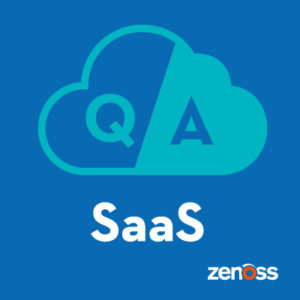
If you own a business, chances are part or all of your operations exist in the cloud. Cloud adoption grew steadily in 2016, jumping from 62 percent to 77 percent in one year (Rightscale 2016 State of the Cloud Report). Adoption rates will increase further as cloud service providers continue to optimize solutions. Part of what drives cloud adoption—particularly hybrid cloud adoption—is the as-a-service economy, which is producing new offerings at a breakneck pace.
Assess Your Need for SaaS-based Cloud Monitoring
Hybrid clouds give businesses greater flexibility and more elastic computing capacity, sometimes across multiple cloud platforms and providers. To manage multiple platforms in a hybrid cloud environment, however, businesses need an ally. SaaS-based cloud monitoring has become the go-to application for guaranteeing the health and performance of IT services in environments that combine on-premises data centers. This approach enables businesses to integrate public cloud services such as Huddle, Google Apps, and Office 365 with infrastructure as a service (IaaS) and platform as a service (PaaS) such as Amazon Web Services (AWS), Microsoft Azure, Engine Yard, Oracle and Google App Engine. It also allows a business to monitor private cloud services and on-premises environments without the requirement to constantly switch between different dashboards, and it achieves hybrid IT simplification by arming IT teams with service-centric monitoring capabilities.
The cloud should be a resource that makes business operations more efficient, precise, and agile. Yet as many companies gradually put more IT services in the cloud, they commonly add new tools piecemeal to monitor the cloud components. In doing this you can end up having a complex web of monitoring tools that don’t communicate with each other. This method is a burden on resources and lowers the overall return on investment (ROI). Instead of tangling with a web of disparate monitoring tools, it’s far better to invest in unified cloud and data center monitoring as a service. This eliminates the patchwork and streamlines multiple monitoring apps into one comprehensive solution.
Reap the Benefits of Optimized Cloud Monitoring
Going forward, cloud monitoring as a service will be a necessity for every business that uses cloud-based platforms. The benefits far outweigh the costs and will optimize the way businesses use the cloud for years to come. This approach enhances IT service health & performance, data integrity, analysis, and security all in one user-friendly, cost-effective bundle. Furthermore, this approach can scale with your company, which is one of the biggest advantages of cloud adoption to begin with.
Other benefits of cloud monitoring as a service
- Easily manage hybrid cloud multi-cloud and environments. No matter how many types of cloud platforms your business uses, monitor them into one unified solution.
- Accelerate your ability to deploy new IT services. Not only do these solutions allow you to take advantage of the monitoring capabilities within minutes, they enable you to rapidly and reliably deploy services at the speed your business requires.
- Deploy and change your solution with ease. Monitoring as a service is as flexible and scalable as the cloud itself. Scale your deployment elastically, spending exactly what you want for the services you need and none you don’t need.
- See all service components in the IT value chain in one view. When you consolidate your monitoring tools into one service, you can access data from any source quickly through a single interface.
- Minimize the impact of IT service issues. The cloud still isn’t magical – there is infrastructure involved so there are still occasional unavoidable issues, but these setbacks don’t have to hurt your business. SaaS-based monitoring providers can identify issues before disruptions occur, eliminating IT service outages and thus eliminating the negative business impact.
- Optimize costs. Multiple applications for hybrid cloud monitoring can quickly build up a mountain of costs, in licenses as well as inefficiencies. Save money by trusting a unified solution for full stack monitoring and end-to-end visibility.
- Improve SLAs. SaaS-based monitoring solutions have proven track record of reducing service-impacting incidents, minimizing downtime through holistic resource monitoring, and dramatically reducing mean time to resolution (MTTR). This enables you improve your service-level agreements (SLAs) with the businesses you serve.
- Free your team for business-enabling projects. With the vendor managing deployment, backup and restore, and patching services, you can greatly reduce staff burden and hardware overhead associated with hybrid IT monitoring. The hosted services also ensure that you are always using the latest, most advanced version without any demand on your team.
- Master predictive analytics. These solutions don’t simply monitor your cloud platforms—they enable faster and more accurate predictive analytics. Turn your data into useful, actionable information about your brand and consumer behaviors.
- Enhance situational awareness. In today’s fiercely competitive business environment, a brand must stay on top of what’s happening around itself in the industry to survive. SaaS-based monitoring can help with this situational awareness by keeping a brand informed about its current successes and failures.
If your company is spending too much time, energy and money monitoring a hybrid IT environment, SaaS-based monitoring can transform your business. This approach frees up IT team members to focus on other aspects of business, such as cybersecurity or new business software integration. It lessens the burden on your budget by reducing myriad monitoring services to just one. It consolidates services across many suppliers and platforms into one unified interface. It is becoming a must-have solution for any business that operates any portion of their IT services in the cloud.
Daniel Newman is CEO of Broadsuite Media Group, President of V3 Broadsuite and a keynote speaker around the world on topics such as digital transformation, cloud, technology and marketing. He the author of best selling books including "Building Dragons: Digital Transformation in the Experience Economy." Daniel will be a keynote speaker this April at Zenoss GalaxZ17 User Conference.






